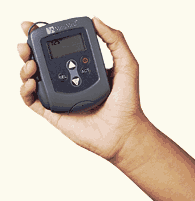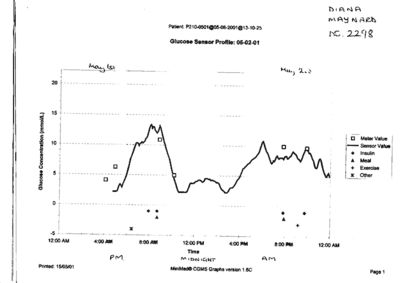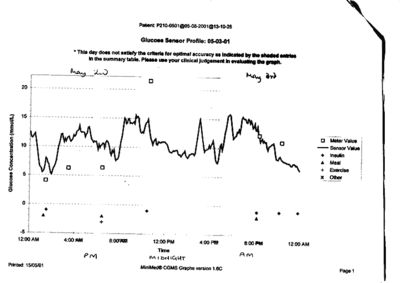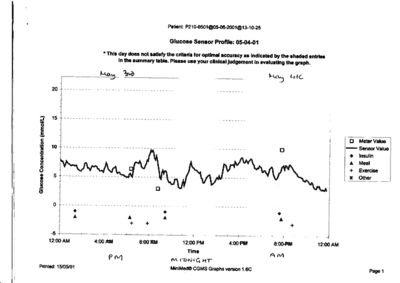This page as a pdf file
My CGMS test
Diana Maynard tested a continuous glucose monitor, and found the results erratic
On this page
Introduction
Earlier this year I took part in some clinical research which involved being hooked up to the Minimed 24 hour glucose sensor for 3 days. This is an account of how I got on, and an analysis of the results.
Photo of MiniMed Continuous Glucose Monitoring System

Setting up
The experiment involved being connected to a heart rate monitor for 2 nights, and measuring the correlation between heart rate and blood sugar levels. In particular, the study was interested in the correlations between heart rate and hypos. Because the glucose sensor runs from midnight to midnight, the time on the sensor was changed by 12 hours, so that for example it read 12am when it was actually 12pm. This makes it a little confusing when looking at the graphs.
Wearing the sensor is very similar to wearing a pump. It is inserted under the skin with something similar to a Minimed SofSet. I never got on very well with the SofSets, as I found they irritated my skin after a day or so, and I found them slightly uncomfortable. After a day on the sensor, I did find it starting to irritate my skin, but I managed to put up with it for the whole 3 days. The tubing is somewhat thicker than the pump tubing, which makes life a little more awkward, but all in all, it is easy enough to wear. I wore the device clipped to my waistband, and my pump in my pocket (on the other side). By the time I was also wired up to the heart rate monitor every night, with 3 more leads connected to a palmtop computer on the floor beside the bed, I really did feel more like a cyborg than a human being! I gave up worrying about what would happen to everything in bed, and just put the pump and sensor together in the bed and hoped the leads wouldn't be hopelessly tangled by morning!
The results of the sensor were not as useful as I'd hoped, for various reasons. Firstly, I had 3 very untypical days as far as my control went. A bad site meant that I spent much of one day and night with high BGs. I had some unusual readings on the other 2 days that were not very typical either. Secondly, there were some major discrepancies between my meter readings and the sensor. On 2 of the 3 days, there were such big discrepancies that it was advised not to take the sensor readings too seriously. I would tend to prefer my meter readings over the sensor readings, because the actions I took when my blood sugar was high would have resulted in severe hypos had I really been at the levels the sensor indicated.
Running
Tuesday 1st
Graph of Tuesday glucose sensor results
[ See graph bigger ]
I started the trial on Tuesday at 4pm. At the time my BG was 4.1 mmol/L (74 mg/dL), although the sensor showed a slightly lower level. At 6pm I had an apple (10g carb) and went to the gym from 6.30 to 7.30pm. During this time I switched off the pump. I was unaware that my BG was climbing throughout my workout in the gym. At 7.30 my BG was 10.3 mmol/L (185 mg/dL), so I took a unit of insulin. By 8.30pm I was home, and tested again. My BG was still 10.3 mmol/L (185 mg/dL). I then had 55g carbs (pasta and a yoghurt) and took 5 units (3 for the carbs, and 1.5 for the high BG). By 10pm my BG was down to 5 mmol/L (90 mg/dL) - clearly I had taken too much insulin. Sometimes my BG doesn't come down readily after exercise, which is why I was a little heavy-handed on the correction bolus. At 11pm I went to bed, thinking everything was fine. Clearly my BG was still falling, as the sensor shows, and I was hypo most of the night until about 4am when my BG began to rise sharply. This was an interesting discovery, because on waking with a high BG the next morning, I assumed my BG had slowly risen through the night.
Wednesday 2nd
Graph of Wednesday glucose sensor results
[ See graph bigger ]
Woke at 7.50am with a BG of 10.2 mmol/L (184 mg/dL). Took 0.8 units as a correction bolus. The sensor was measuring lower at this point, as the graph shows. I changed my infusion set at this point. At 8am I had a small bowl of Grape Nuts and a muffin, and took 3.5 units of insulin. I decided to experiment with the square wave bolus, and took 2 units immediately, and the remaining 1.5 units over the next 2 hours. This was in preparation for my walk to work. At 9.10 I walked the 20 minutes to work. At 10am my BG was 9.8 mmol/L (176 mg/dL), so I took a unit of insulin. At 11am I tested again, and found my BG had risen to 13.9 mmol/L (250 mg/dL). The sensor was again reading much lower - below 10 mmol/L (180 mg/dL). I took 2 units of insulin. I decided at this point that the infusion set was the problem, so I changed to a new set. At 1.20pm my BG had finally dropped to 4.1 mmol/L (74 mg/dL). The sensor, however, read 7 mmol/L (126 mg/dL). For lunch I had 35g carb - an apple, a banana, and a small pot of cottage cheese - and took 1.6 units (less than I would normally take, since I was on the low side). At 4pm my BG was 6 mmol/L (108 mg/dL), although the sensor was now reading 12 mmol/L (216 mg/dL). Similarly at 6pm my BG was 6.3 mmol/L (113 mg/dL), but the sensor was reading much higher again. I had 15g carb, set my pump to 50% for the next hour, and walked for 20 mins to my dance class. I danced for 2 hours, and didn't test again till I got home at 10pm. According to the sensor, my BG had been steadily climbing and was now at 15 mmol/L (270 mg/dL). At 10pm I was surprised to find my BG had rocketed to 21 mmol/L (378 mg/dL). I took 5 units of insulin and went to bed. During the night, the sensor showed a whole series of peaks and falls.
Thursday 3rd
Graph of Thursday glucose sensor results
[ See graph bigger ]
Woke up at 8am with a BG of 11.5 mmol/L (207 mg/dL). Had 30g carb - toast and a banana - and 2 units of insulin, and walked to work at about 9am. At 11am my BG was 11 mmol/L (198 mg/dL), although again the sensor was reading lower. I took a unit of insulin. By 1.30 my BG had dropped back to 6 mmol/L (108 mg/dL). I had 30 g carb - an apple and a pot of cottage cheese - and 2 units of insulin. All afternoon my BG appeared stable according to the sensor. 6.30pm BG 6 mmol/L (108 mg/dL). Had a banana (10g carb) and walked 20 mins to gym. Switched pump off between 7pm-8pm. Gym from 7.30pm-8.30pm. 9pm BG 3.5 mmol/L (63 mg/dL) (although the sensor showed a rise followed by a drop). Got home at 9.30pm, ate salad and went to bed at 11pm.
Friday 4th
During the night all appeared to be well, with my BG level fluctuating between 4 mmol/L (72 mg/dL) and 8 mmol/L (144 mg/dL) all night, though there was a marked steady rise between 2 and 4am and then a gradual dip from 4am to 8am. This might suggest that my increased basal to coincide with the dawn syndrome is actually starting too late, and is only kicking in at 4am. However, my meter showed 10 mmol/L (180 mg/dL) at 8am, whereas the sensor showed around 7 mmol/L (126 mg/dL), so I would be reluctant to rely on the meter results too much.
At 8am I had a bowl of cereal and 2 units of insulin, and walked to work at about 8.30am. This time my BG slowly decreased throughout the morning to around 3.5 mmol/L (63 mg/dL) at 12pm acccording to the sensor, although my meter showed that I was at 6.5 mmol/L (117 mg/dL) at the same time. At this point I was quite glad to disconnect the sensor, as it had really started to irritate my skin.
Conclusion
From the results, it is hard to make any real judgements, because so much of the time it didn't correlate with my meter readings (which I believe to be reasonably accurate). I suspect though that I am indeed suffering undetected hypos at night, and that there may well be strange things going on when I exercise that I hadn't taken into account. All in all, it was an interesting experience, but difficult to draw any real conclusions from.
Created: September 2001; Last updated: Saturday 13 July 2002
Other pages about blood testing
[ Wearing a continuous glucose sensor | My CGMS test | CGMS accuracy | Continuous Glucose Monitoring System | Cygnus GlucoWatch | Hypo review ]
Reader comments
Nobody has left a comment on this page yet. Why not be the first?



